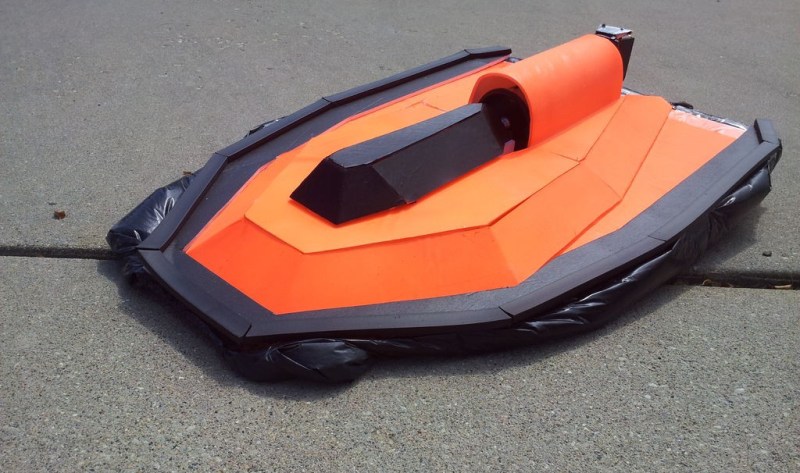Of all the homemade RC Hovercraft floating around out there, this build is not only one of the better looking: it’s also unexpectedly quick. [ScratchBuiltAircraft] sourced foam board from the local dollar store to construct the hovercraft’s body and a heavy-duty garbage bag with a hole cut in the center for the skirt. Air reaches the skirt area from the hovercraft’s EDF (Electric Duct Fan — the big one on the back) which pumps the air through a rectangular hole in the base.
A servo mounted behind the fan controls the rudders, while the rest of the electronics and the battery are cleanly tucked away beneath foam body pieces. We’re not sure what kind of top speed the Turnigy motor provides, but it’s probably impressive assuming it can keep from flipping over. Watch it blast off with a bit too much lift in the video below.
For something a bit slower, there’s always the solar powered hovercraft from earlier this summer.
[via Hacked Gadgets]
















it would probably help to balance the weight and then attach an inverted airfoil to keep it from taking off at speed
It’s a nice build form scrap, but I’d hardly say it was fast or especially stable.
The instrutables page describes how the driving fan was previously used on a craft that flew at 60-70 m.p.h.
This thing seemed to either dig in at the front or flip doing anything over maybe 10 miles an hour.
It’s more stable than you’d think. There is an entire following to foam built aircraft.
Foam aircraft can be stable, but this build looks like its going to hits its nose on the road.
Non sequitur. Because there is a number of people that create foam aircraft does not mean that our eyes are deceiving us and this specific hovercraft is, in fact, not flipping over at any speed faster than a brisk walk.
Nice try, but it looks like it needs better trimming. Whenever he applies power, the front end dives into the ground, and the back end lifts. I think it’s because of the positioning of the fan. It’s still quick, but that’s mostly due to the sheer amount of power and lack of weight, as it still seems to be dragging a bit too much. I’d be inclined to add some sort of fin in the outlet of the fan, to try and push the back end down again. That ought to balance it out when he applies power, meaning that he gets properly in the air, and gets even more speed. I’ve previously built an RC hovercraft, and that took quite a bit of fiddling to get right. It’s still rather on the heavy side, so it’s due a mk2.
It’s inspiring me to try one as well! This guy should show how well it works on low-cut grass and water.
Most RC hovercraft have the thrust pointed upwards slightly to keep the nose from digging in as you apply power. When it’s pointed straight, the thrust causes the hovercraft to pitch down.
Looks like it could benefit from some rudders — it steers well, but seems like it has trouble going straight at high speed. Nice platform for additional experimentation, though.
Nice ,made a miniature one of these a few years ago from zipzap parts. Looks plenty fast to me. Like someone else said, a downward airfoil will def help with the lifting effect. Maybe a few weights in the rear too. Otherwise a very nice job of it! You do us Foamies Proud.
I suspect the digging in, as well as the speed issues, etc can all be corrected with a much more efficient skirt design. Most of the ‘difficult’ engineering is in the skirt. A trashbag made for a quick proof of concept, and it ‘works’ but not that well.
A better design would be to use tubes around the sides, with many smaller holes along the bottom face.
It needs an elevator in the exhaust flow that’s tied to the throttle so that as throttle is increased the elevator automatically compensates by applying downforce to the rear.
A solid state gyro would help with that and steering to stabilize pitch and yaw. Any sort of static wings or fins will only work in a narrow speed range.
Pretty cool project, despite minor flaws here or there. Shows lots of potential and definitely something that others will enjoy recreating and/or modifying in the future. Thanks for sharing!
I think the CG is off a bit, by the way it moves. It’s as important on a hovercraft as on an aircraft…